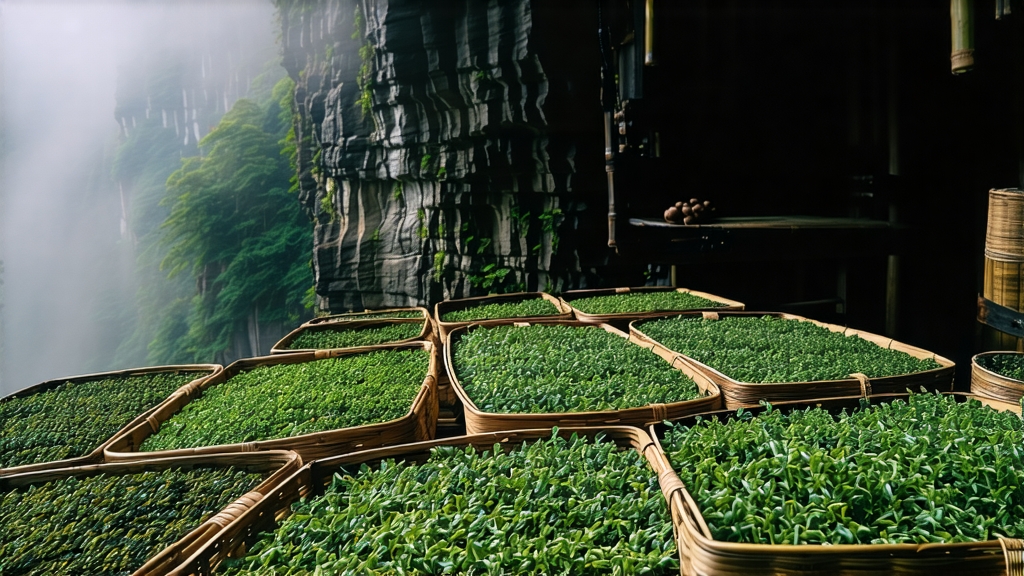
Few teas ignite the Western imagination as fiercely as Lapsang Souchong. Mention it in a London tearoom or a Brooklyn café and faces light up with the memory of campfires, leather-bound books, and winter nights. Yet beyond the romantic haze lies a precise, centuries-old craft born in the granite gorges of China’s Wuyi Mountains, a craft that turned a modest village leaf into the world’s first black tea and, later, into its most aromatic outlier.
History: From Ming-Era Accident to Global Obsession
Local legend fixes the birth year around 1567, late Ming dynasty, in the hamlet of Tongmu on the Fujian-Jiangxi border. Bandits had delayed the annual green-tea caravan; to save the harvest, farmers rushed the leaves through extra withering and drying over massed pine fires. The resulting dark, smoky tea—dubbed “Xiao Zhong” (“small cultivar”) to distinguish it from the coarser “Da Zhong”—reached Amsterdam by 1604 and was an instant sensation. European merchants shortened “Xiao Zhong” to “Souchong,” prefixed it with the Cantonese “Laap-saang” (“pine-smoked”), and a star was coined. By the Qing era, Lapsang Souchong anchored the bohea (Wuyi) category that filled the holds of East India Company clippers; even the Boston Tea Party crates were stamped “Bohea Souchong.”
Micro-Terroir: Why Only Tongmu Tastes Like Tongmu
The Wuyi range is a UNESCO geopark of 600-million-year-old rhyolite cliffs, humid subtropical air, and mineral-slick streams. Within this crucible, Tongmu village sits at 27° 45′ N, 600–1,200 m above sea level, wrapped in bamboo and masson pine. Diurnal swings of 15 °C force slow growth, concentrating amino acids, while the pine forests provide the resinous fuel that defines the tea. Chinese law now restricts tea labeled “Zheng Shan Xiao Zhong” (Original Mountain Siao Souchong) to the 600-hectare core of Tongmu; everything else is simply “smoked black tea.”
Cultivars: The Leaf Behind the Smoke
Traditionalists insist on the indigenous Xingcun or Cai Cha bushes—small-leaf, slow to bud, but high in sugar and low in catechins, ideal for smoke absorption. Since 2005, clonal Wuyi Qizhong (a Dancong hybrid) has been trialed for higher yield, yet connoisseurs swear the old bushes give a sweeter, cooler finish. Leaves are picked only in late April, when three half-opened leaves crown each stem, ensuring enough surface area for withering yet sufficient heft to endure firing.
Craft: Seven Steps to Smoke
- Pluck: dawn harvest, 5–9 a.m., avoiding rain-slick leaves.
- Withering: 8–10 hours on bamboo screens set over riverside racks; cool valley air reduces moisture to 60 %.
- Rolling: 40 minutes of machine-assisted bruising (hand-rolling disappeared in the 1980s) to rupture cells and release enzymes.
- Oxidation: four hours in wooden troughs at 24 °C, 85 % humidity; leaves turn chestnut with a faint apple note.
- Pan-firing: 220 °C for two minutes to arrest oxidation, leaving 20 % residual moisture.
- Smoking: the signature step. Fresh pinewood is ignited in an earthen floor pit, then smothered to produce cool, aromatic smoke (35–40 °C). Trays of tea are stacked 2 m above the pit for 6–8 hours, absorbing guaiacol and syringol compounds that create the trademark tarry sweetness.
- Final drying: 80 °C for 30 minutes to lock in 5 % moisture, followed by a month of “smoke rest” so aromas marry.
Two Styles: Traditional Smoke vs. New-Age Fruity
In Tongmu you now meet two streams. The classic “Song Zhong” (pine-smoked) is repeat-smoked for up to three cycles, yielding a jet-black, glossy leaf and a liquor like burnt honey and cured meat. Since 2005, innovative producers have omitted smoking altogether, selling an unsmoked “Zheng Shan Xiao Zhong” that stee